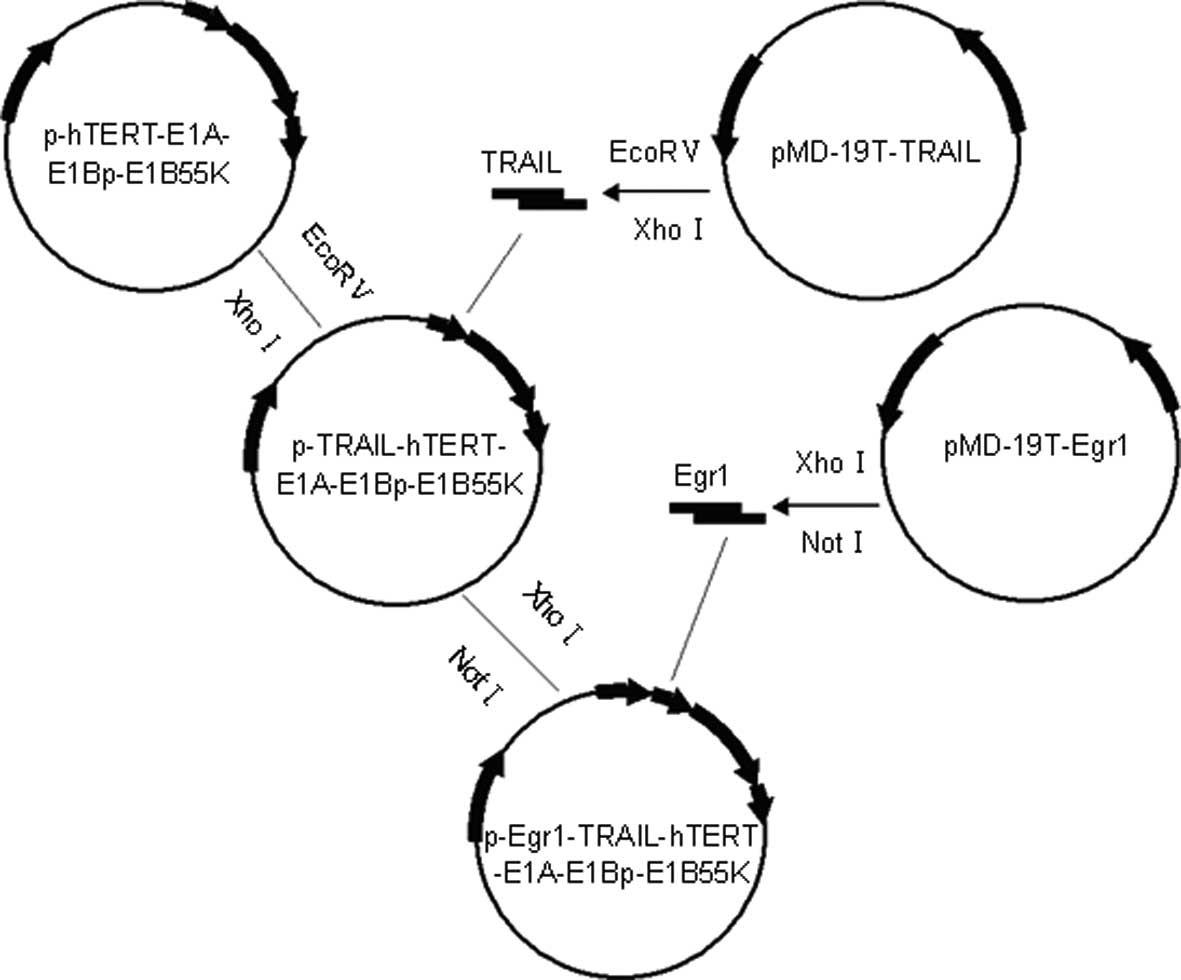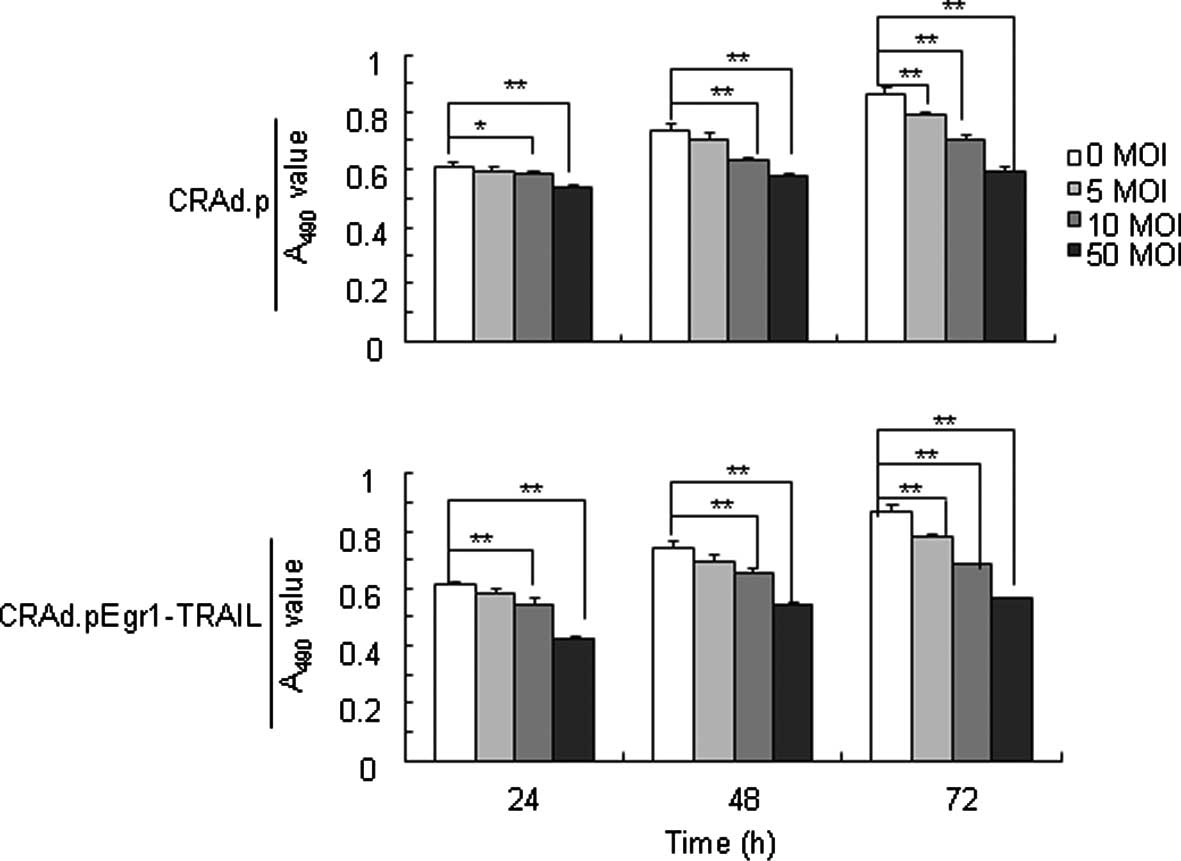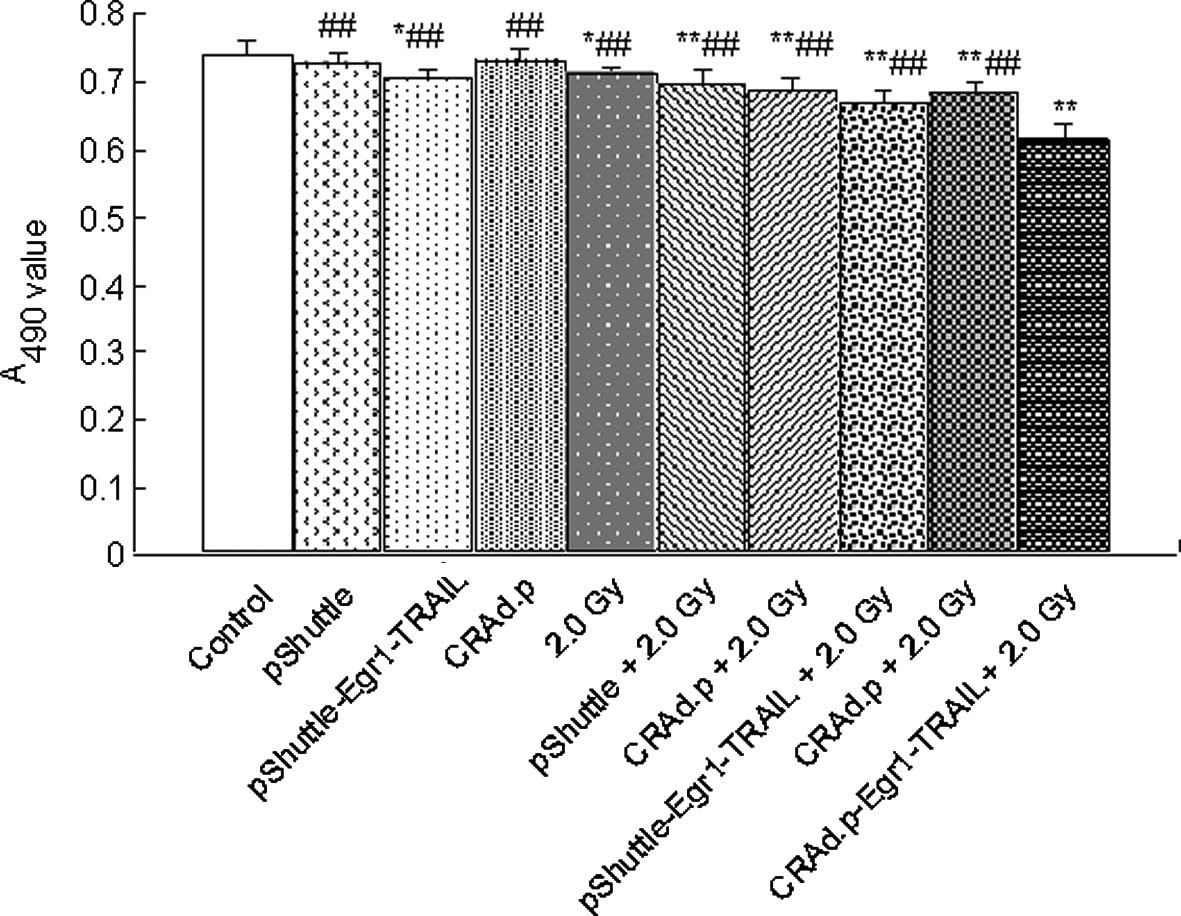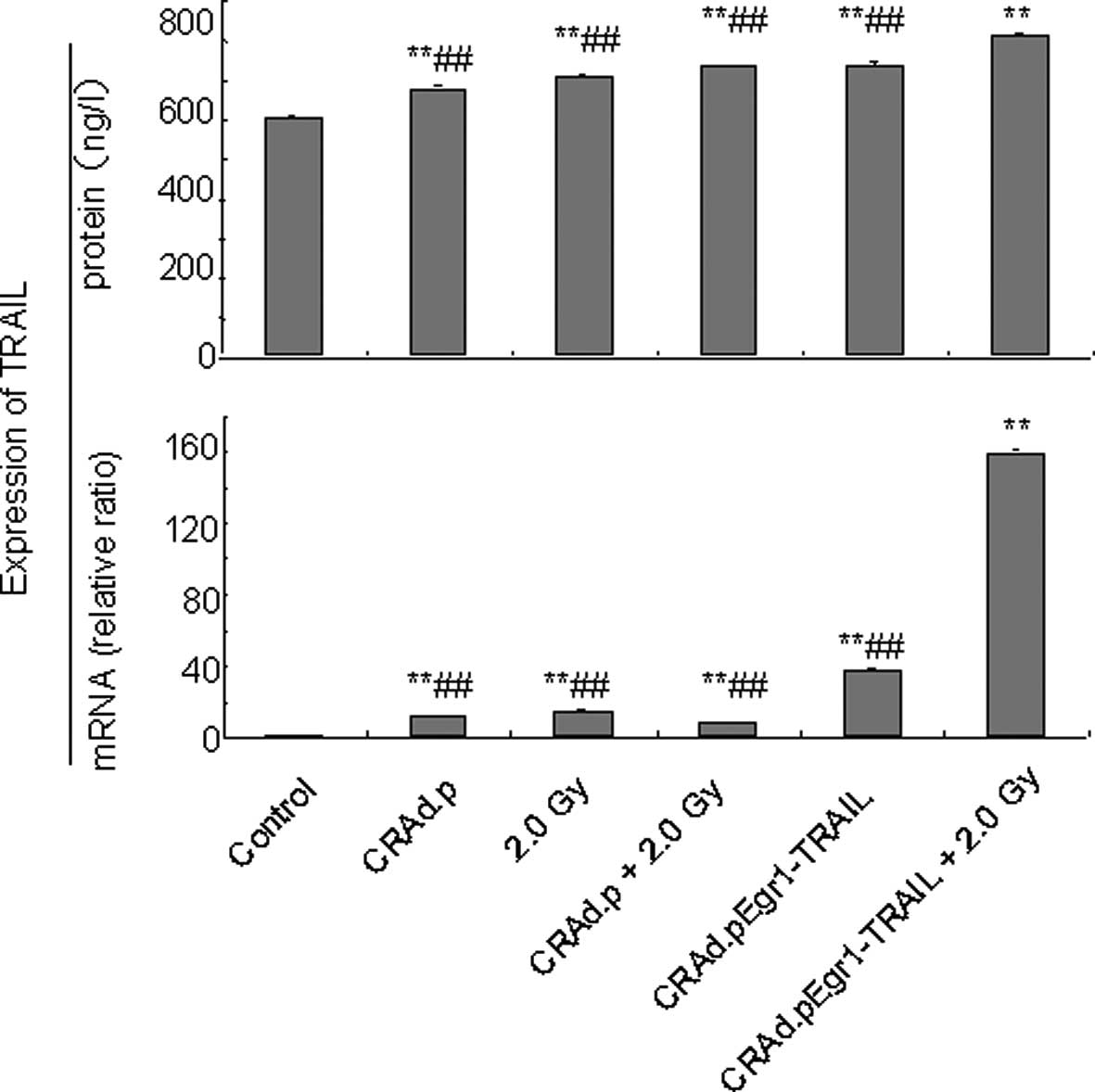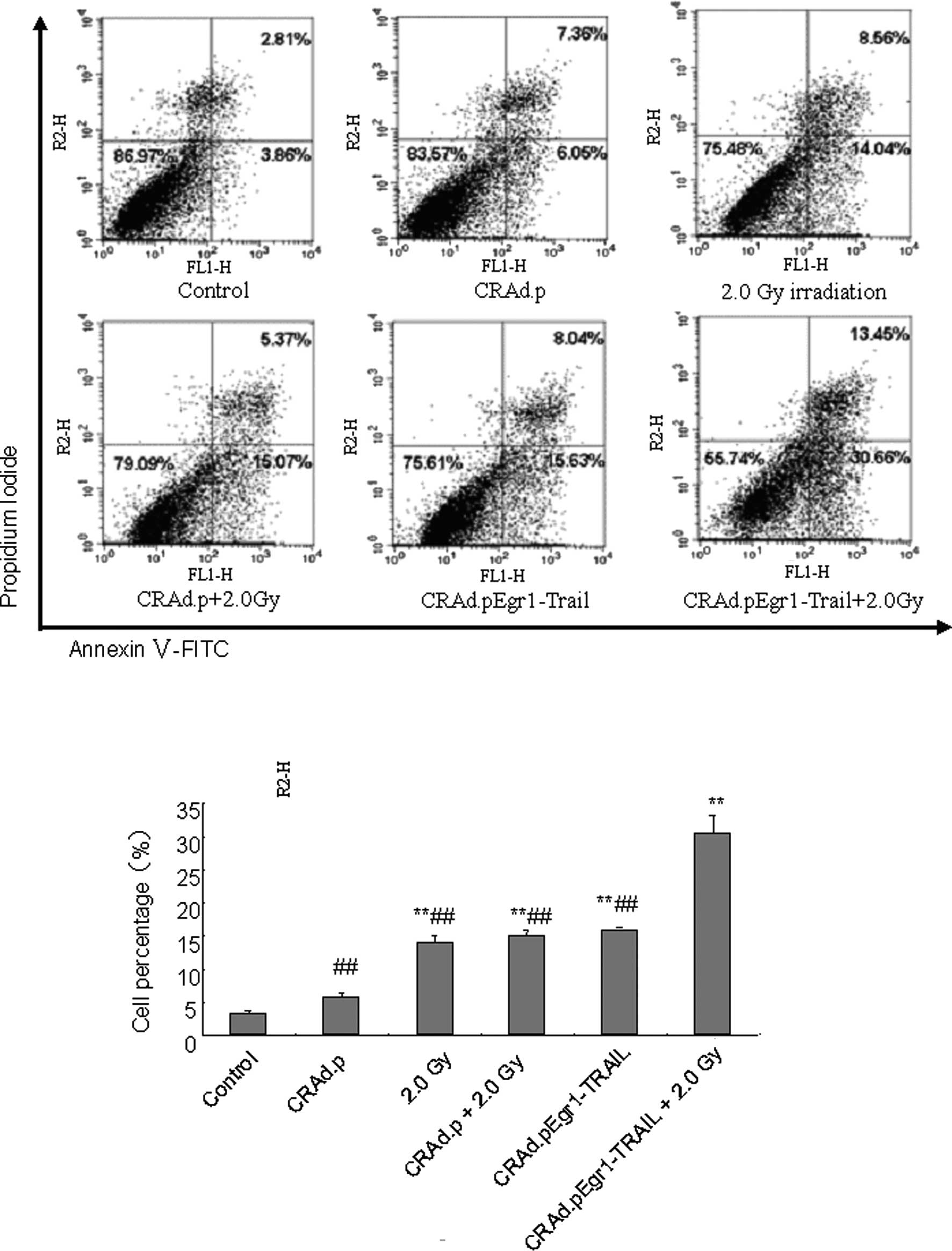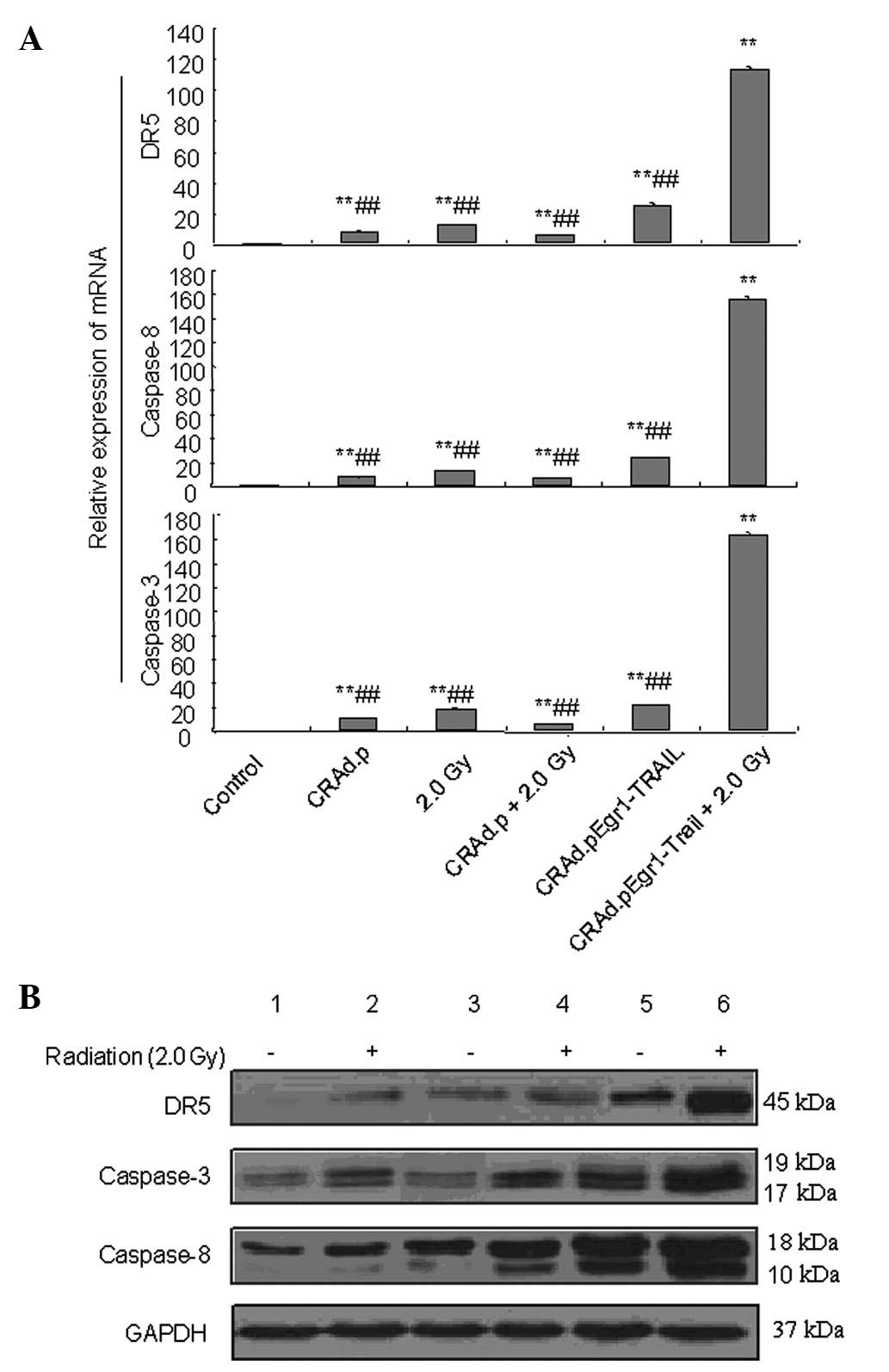Conditionally replicating adenovirus combined with gene-targeted radiotherapy induces apoptosis via TRAIL death receptors in MDA-MB-231 cells
- Authors:
- Published online on: May 23, 2013 https://doi.org/10.3892/mmr.2013.1488
- Pages: 299-305
Abstract
Introduction
Malignant tumors constitute a threat to human health. Traditional methods for treating tumors are surgery, radiotherapy, chemotherapy and biological therapy; however, monotherapy often has its own limitations. Therefore, various means of combined therapy for tumors have become a hot topic.
On the basis of the respective characteristics of radiotherapy and gene therapy, Weichselbaum et al proposed the use of tumor gene-radiotherapy (coupling the regulatory sequence of the ionizing radiation-induced gene and the tumor-killing gene to be transferred into irradiated tumor cells), thus inducing the expression of the tumor-killing gene and forming a synergism of inhibiting tumors by ionizing radiation and gene suppression (1). Early growth response-1 (Egr1), identified by Sukhatme et al(2) is activated by ionizing radiation, free radicals and hypoxia to induce the expression of downstream genes (3–5). According to the characteristics of the Egr1 gene induced by ionizing radiation, the ionizing radiation-inducing expressive system is constructed with the cis-acting element of the Egr1 promoter region, which controls the temporal and spatial expression of target genes to produce the synergistic killing effect on tumor cells and decrease the cytotoxic effect on normal tissues. Weichselbaum et al(6) first constructed the expressive plasmid pEgr1-tumor necrosis factor-α (TNF-α) and performed a series of studies on tumor gene-radiotherapy with TNF-α as a theoretical gene. The authors demonstrated that the plasmid with radiotherapy inhibited tumor growth and decreased the local and systemic toxic effects (7–9).
Gene therapy is a method employed to treat tumors. The degree of safety and high-performance of the expression vector determines the efficacy. Conditionally replicating adenovirus (CRAd), also known as oncolytic adenovirus, is an ideal tumor-treatment vector since it replicates specifically in tumor cells. Progeny virus released from the vector infects the vicinity of tumor cells and then initiates a cascade amplification reaction, leading to cell disruption, eventually eliminating the cell population (10,11). Yu and Fang demonstrated that CRAd H101 in combination with chemotherapy has favorable tolerance and curative effects on certain tumors (12). Due to the potential of CRAd, it has been previously tested in a clinical trial and its safety has been confirmed (13). Gene therapy with CRAd has become a hot spot in tumor gene therapy (14), since CRAd specifically infects and kills tumor cells without damaging normal cells (15). There is no crossing drug tolerance between CRAd therapeutics and traditional tumor therapeutics. In addition, the combination of CRAd with radiotherapy and chemotherapy achieves a superposition or synergism (16,17). TNF-related apoptosis inducing ligand (TRAIL), cloned by Wiley et al(18), is a member of the TNF superfamily. TRAIL induces apoptosis in tumor, transformant and virus-infecting cells, but does not damage normal cells (19–22). TRAIL, not only has a killing effect on tumor cells, but also induces the apoptosis of tumor cells when combined with radiotherapy, which produces the synergistic effect of killing tumor cells, as well as increasing the sensitivity of TRAIL to irradiation. Studies (19,20,22,23) have confirmed that ionizing radiation upregulates the expression of TRAIL and death receptors 4 and 5 (DR4 and DR5), and promotes the apoptosis of tumor cells. TRAIL in combination with radiotherapy has apparent synergistic effects, producing good curative effect on treating breast cancer in preclinical experiments and one/two-stage clinical trials (22,23). If the TRAIL gene is constructed downstream of the Egr1 gene promoter, ionizing radiation induces and activates the Egr1 gene, which regulates the expression of the downstream TRAIL gene, increasing the curative effect of gene-radiotherapy on tumors.
In the present study, the Egr1 promoter and TRAIL gene were inserted into a CRAd vector, which contained the original CR2 region-deleted E1A gene controlled by the human telomere reverse transcriptase (hTERT) promoter. The recombinant expression system integrated three functions: i) the CRAd vector has a double targeting effect in tumor cells, disrupting tumor cells; ii) radiotherapy kills tumor cells and induces the transcription of the Egr1 promoter, which triggers TRAIL; and iii) the TRAIL gene promotes apoptosis of tumor cells. The recombinant multifunctional expression system CRAd.pEgr1-TRAIL combined with ionizing irradiation were used to kill human breast cancer cells. Integration of radiotherapy, virus therapy and gene therapy may provide a new approach to the combined therapy of malignant tumors.
Materials and methods
Cell lines and reagents
MDA-MB-231 and MCF-7 human cancer cell lines were obtained from the Shanghai Institute of Cell Biology, Chinese Academy of Science (Shanghai, China). MDA-MB-231 cells were maintained in L-15 medium (Sigma, St. Louis, MO, USA). MCF-7 cells were cultured in complete Dulbecco’s modified Eagle’s medium (DMEM; Sigma) supplemented with 10% fetal bovine serum (FBS; Gibco-BRL, Grand Island, NY, USA), 100 U/ml penicillin and streptomycin (Gibco-BRL) and incubated at 37°C, 5% CO2. Anti-human caspase-8 and -3 and anti-human glyceraldehyde 3-phosphate dehydrogenase (GAPDH) monoclonal antibodies were purchased from Cell Signaling Technology Inc. (Boston, MA, USA). The anti-human DR5 monoclonal antibody was purchased from Millipore (Billerica, MA, USA). Horseradish peroxidse (HRP)-labeled rabbit anti-goat polyclonal antibody was from Santa Cruz Biotechnology, Inc. (Santa Cruz, CA, USA).
Recombinant adenovirus
The shuttle vector pShuttle-Egr1-TRAIL-hTERT-E1A-E1Bp-E1B55K was transformed into BJ5183 (pAdEasy-1+) competent cells, forming CRAd.pEgr1-TRAIL through homologous recombination (Fig. 1). The adenovirus was amplified in HEK293 cells and prepared by a standard CsCl method. The adenovirus titers were measured by the TCID50 method and the acquired value was recalculated as pfu/ml.
X-ray irradiation
MDA-MB-231 cells were irradiated using X-rays generated by a Philips X-ray machine (XSS 205FZ; settings: 180 kV, 12 mA and filters of 0.5 mm Cu and 1.0 mm Al) to deliver doses of 1–5 Gy at a dose rate of 0.387 Gy/min and a target skin distance of 60 cm.
Cell viability assay
The cytotoxicities of plasmids and CRAd in MDA-MB-231 cells were assessed by Cell Counting Kit-8 (CCK-8; Dojindo Molecular Technologies, Japan). Briefly, the cells were seeded in 96-well plates at a density of 2×104 cells/well and treated with pShuttle, pShuttle-Egr1-TRAIL, CRAd.p and CRAd.pEgr1-TRAIL, respectively. The untreated cells were used as a control group. After 24 h, the cells were irradiated with a dose of 2.0 Gy. Twenty-four hours after irradiation, CCK-8 was added to each well, followed by incubation at 37°C for 1 h. The optical absorbance value of each well was measured at 490 nm on a microplate reader (Bio-Rad, Hercules, CA, USA).
Flow cytometry
Cell apoptosis was assessed by flow cytometry with Annexin V and propidium iodide (PI) double-staining. Cells were seeded in 24-well plates at a density of 3×105 cells/well one day prior to treatment. Then, the cells were treated with CRAd.p or CRAd.pEgr1-TRAIL at a multiplicity of infection (MOI). After 24 h, the cells were irradiated with 2.0 Gy. Twenty-four hours after irradiation, the floating and attached cells were collected and washed with phosphate-buffered saline (PBS). Binding buffer (500 μl) mixed with 5 μl Annexin V-fluorescein isothiocyanate (FITC) and subsequently with 5 μl PI was added to 5×105 cells, followed by incubation at room temperature in the dark for 10 min. The stained cells were then analyzed using a FACSCalibur device (BD Biosciences, San Jose, CA, USA).
Real-time polymerase chain reaction (PCR)
MDA-MB-231 cells were seeded in 6-well plates at a density of 5×105 cells/well and cultured for 24 h, and then treated with CRAd.p or CRAd.pEgr1-TRAIL at 5 MOI. After 24 h, the cells were irradiated with 2.0 Gy. Eight hours after irradiation, total RNA was extracted using TRIzol reagent. The RNA concentration and purity were determined using a spectrophotometer. A total of 200 ng RNA was reverse-transcribed into cDNA. Real-time fluorescent quantitative PCR was performed with the cDNA template using the SYBR® reverse transcription (RT)-PCR kit and the Stratagene Mx3000P Real-Time PCR System (Agilent Technologies Inc., Santa Clara, CA, USA) according to the manufacturer’s instructions. PCR was performed as follows: 1 cycle of 95°C for 30 sec; 40 cycles of 95°C for 20 sec and 60°C for 20 sec (fluorescence was collected at this stage); and 1 cycle of 95°C for 1 min, 55°C for 30 sec and 95°C for 30 sec. The primers (Table I) were synthesized by Sangon Biotech Co., Ltd. (Shanghai, China). For the data analysis, the comparative threshold cycle (CT) value for GAPDH was used to normalize the loading variations in the real-time PCR reactions.
Enzyme-linked immunosorbent assay (ELISA) for TRAIL
MDA-MB-231 cells were seeded in 6-well plates at a density of 5×105 cells/well. Following overnight incubation, the cells were treated with CRAd.p or CRAd.pEgr1-TRAIL at 5 MOI. After 24 h, the cells were irradiated with 2.0 Gy. Twelve hours after irradiation, the levels of TRAIL in the supernatant of the cell culture were determined by ELISA according to the manufacturer’s instructions (R&D Systems, Minneapolis, MN, USA).
Western blotting
MDA-MB-231 cells were cultured overnight in 25 cm2 culture flasks and then treated with CRAd.p or CRAd.pEgr1-TRAIL at 5 MOI. After 24 h, the cells were irradiated with 2.0 Gy. Twelve hours after irradiation, the cells were washed with cold PBS and lysed in Laemmli lysis buffer. Western blot analysis was performed as follows: A total of 60 μg denatured protein samples were loaded onto 12% sodium dodecyl sulfate-polyacrylamide gel electrophoresis (SDS-PAGE) gels, electroblotted onto nitrocellulose membranes and incubated with 5% non-fat dry milk for 1 h. The membranes were then incubated with anti-DR5, anti-caspase-3 and anti-caspase-8 antibodies overnight. GAPDH was used as the housekeeping protein control. Following incubation with HRP-labeled secondary antibody, the blots were developed by enhanced chemiluminescence (ECL) procedures according to the manufacturer’s instructions.
Statistical analysis
Differences among the groups were assessed by analysis of variance (ANOVA) using SPSS 12.0 (SPSS Inc., Chicago, IL, USA). The results are expressed as mean ± standard deviation (SD). P<0.05 or P<0.01 were considered to indicate a statistically significant difference.
Results
Recombinant adenovirus inhibits MDA-MB-231 cells
The cell-killing effect of recombinant adenovirus was analyzed by a CCK-8 Kit. The inhibitory effect on MDA-MB-231 cells treated with CRAd.pEgr1-TRAIL and CRAd.p, respectively, at 0, 5, 10 and 50 MOIs presented a dose- and time-dependent pattern (Fig. 2).
CRAd.pEgr1-TRAIL combined with 2.0-Gy irradiation enhances cytotoxicity to MDA-MB-231 cells
To determine whether CRAd.pEgr1-TRAIL improves antitumor activity, MDA-MB-231 cells were treated with pShuttle, pShuttle-Egr1-TRAIL, CRAd.p and CRAd.pEgr1-TRAIL, respectively. Twenty-four hours after irradiation, the cell viability was assessed by a CCK-8 Kit. MDA-MB-231 cells treated with pShuttle, pShuttle-Egr1-TRAIL, CRAd.p and CRAd.pEgr1-TRAIL, respectively, were inhibited compared with cells treated without virus (P<0.01). Moreover, the cytotoxicity in the CRAd.pEgr1-TRAIL plus 2.0-Gy irradiation group was stronger compared to that in other groups (P<0.05 for each; Fig. 3).
Enhanced expression of TRAIL and apoptosis in MDA-MB-231 cells induced by CRAd.pEgr1-TRAIL in combination with 2.0-Gy irradiation
To investigate whether an enhanced expression of TRAIL resulted in increased anticancer effects, expression of the TRAIL gene in MDA-MB-231 cells was detected by real-time PCR and ELISA. Fig. 4 (upper panel) shows that the level of TRAIL mRNA expression in the CRAd.pEgr1-TRAIL plus 2.0-Gy irradiation group was much higher compared to that in other groups (P<0.05 for each). TRAIL mRNA expression in the CRAd.pEgr1-TRAIL plus 2.0-Gy irradiation group was 159-fold higher than that in the control group (P<0.01). ELISA revealed that TRAIL protein expression increased in all groups 24 h after 2.0-Gy irradiation and increased significantly in the CRAd.pEgr1-TRAIL plus 2.0-Gy irradiation group (P<0.01; Fig. 4, lower panel). Cell apoptosis was also detected by flow cytometric analysis. The percentage of cell apoptosis significantly increased 24 h after irradiation in the CRAd.pEgr1-TRAIL plus 2.0-Gy irradiation group (P<0.05 and P<0.01; Fig. 5). These findings indicate that CRAd.pEgr1-TRAIL in combination with irradiation increases the expression of TRAIL, leading to enhanced cell apoptosis.
Increased expression of DR5, caspase-8 and caspase-3 mRNA and protein in MDA-MB-231 cells induced by CRAd.pEgr1-TRAIL in combination with 2.0-Gy irradiation
To elucidate the apoptotic signal transduction pathway in MDA-MB-231 cells affected by CRAd.pEgr1-TRAIL in combination with 2.0-Gy irradiation, real-time PCR and western blot analysis were performed to evaluate the expression of DR5, caspase-8 and caspase-3 mRNA and proteins in cells treated with 2.0-Gy irradiation, CRAd.p, CRAd.p plus 2.0-Gy, CRAd.pEgr1-TRAIL and CRAd.pEgr1-TRAIL plus 2.0-Gy, respectively. Real-time PCR analysis revealed that 8 h after treatment, the expression of DR5, caspase-3 and caspase-8 mRNA was elevated in the irradiation groups, particularly in the CRAd.pEgr1-TRAIL plus 2.0-Gy irradiation group, compared to the non-irradiation groups (Fig. 6A). Western blot analysis revealed that the expression of DR5, cleaved caspase-3 and caspase-8 proteins was upregulated following treatment with CRAd.pEgr1-TRAIL plus 2.0-Gy irradiation (Fig. 6B). These results suggest that CRAd.pEgr1-TRAIL in combination with radiotherapy is involved in the apoptosis of MDA-MB-231 cells.
Discussion
Breast cancer is a type of malignant tumor that constitutes a threat to human health (24). Traditional methods of treating tumors are surgery, radiotherapy, chemotherapy and biological therapy; however, single treatment often has its own limitations. The development of molecular biology has led to the rapid progression of gene therapy in breast cancer, resulting in good curative effect. Tumor gene-radiotherapy implements the organic integration of radiotherapy and gene therapy, and achieves a superposition or synergism. Ionizing radiation has the effect of targeting and regulating the temporal and spatial expression of anti-oncogenes (25,26). Usually, the effect of this combined therapy is obtained by the Egr1 promoter and the targeting effect to kill tumor cells may be increased by CRAd. There are two main pathways in the targeting strategy of CRAd: i) to delete the genes unwanted in tumor cells and wanted in normal cells (27) and ii) to regulate gene expression by the tumor-specific promoter. Additionally, the adenovirus has a cytotoxic effect, increasing the effect of irradiation on the breakdown of tumor cells.
In the present study, the TRAIL gene was constructed downstream of the Egr1 promoter, which has the effect of double targeting and replication of the CRAd vector, pShuttle-Egr1-TRAIL-hTERT-E1A-E1Bp-E1B55K, in tumor cells. The adenovirus with the CR2 region-deleted E1A gene only replicates under the upregulation of telomerase activity and the mutation or inactivation of the Rb gene in tumor cells. The broad-spectrum hTERT promoter was placed upstream of the E1A gene to regulate the expression of the E1A gene. The selection of target genes to induce apoptosis of tumor cells in tumor gene-radiotherapy is extremely important. The TRAIL gene induces the apoptosis of tumor cells by activating the DR, but does not cause toxic effect to normal cells. In the present study, the recombinant virus plasmid was successfully packaged and amplified in HEK293 cells, producing a stable CRAd.
Singh et al determined the sensitivity of TRAIL to the apoptosis of several breast cancer cell lines, suggesting that MDA-MB-231 cells are extremely sensitive to the induction of TRAIL, resulting in apoptosis (28). Therefore, in the present study, human breast cancer MDA-MB-231 cells were selected to explore the suppressing effect of the virus in combination with irradiation. In the present study, the tumor-killing effect in the CRAd.pEgr1-TRAIL group was significantly higher compared to that in the pShuttle, pShuttle-Egr1-TRAIL and CRAd.p groups. This finding suggests that the anticancer effect of the recombinant CRAd with the Egr1 promoter and TRAIL gene is better than that of pShuttle-Egr1-TRAIL and adenovirus vector alone.
Apoptosis is a crucial pathway of tumor cell death following radiotherapy, chemotherapy or apoptotic gene expression. In the present study, the rate of cell apoptosis following irradiation increased in each group. Specifically, the rate of apoptosis in the CRAd.pEgr1-TRAIL plus 2.0-Gy irradiation group was significantly different to that in the other groups (P<0.05 or P<0.01). This indicates that the apoptosis-promoting effect of CRAd.pEgr1-TRAIL plus 2.0-Gy irradiation was better compared to that of simple radiotherapy, simple gene therapy and radiotherapy combined with the adenovirus vector. These results also suggest that the TRAIL gene regulated by Egr1 induces tumor cell apoptosis, exhibiting a synergism for killing tumor cells when combined with ionizing irradiation.
Cell apoptosis is an intricate process, involving a number of apoptotic signaling pathways and is regulated by a series of genes and proteins. Furthermore, the abnormal expression of these mRNAs and proteins are earlier than the occurrence of cell apoptosis. In order to reveal the regulatory effect of irradiation-induced expression and the anti-tumor mechanism of CRAd.pEgr1-TRAIL in MDA-MB-231 cells, we detected the mRNA and protein levels of related genes in the DR pathway. The results revealed that the expression of TRAIL, DR5, caspase-8 and caspase-3 mRNA and protein in MDA-MB-231 cells of each group increased following 2.0-Gy irradiation, which was significantly higher in the CRAd.pEgr1-TRAIL plus 2.0-Gy irradiation group. The mRNA expression occurred earlier than the protein expression. Therefore, we hypothesized that TRAIL is a secreted protein and its secretion process is completed after transmembrane appearance when the signal peptide is excised with signal peptidase. Thus, the peak value of detected TRAIL protein should be later than that of the other three types of proteins. The expression levels of TRAIL, DR5, caspase-8 and caspase-3 mRNA and protein in the CRAd.pEgr1-TRAIL plus 2.0-Gy irradiation group increased and was maintained constantly at a higher level. This result indicates that CRAd.pEgr1-TRAIL combined with radiotherapy induces apoptosis. On the basis of these results, we consider that ionizing radiation activated the Egr1 promoter, which induced the sustained expression of TRAIL mRNA and protein, promoting apoptosis in tumor cells. Simultaneously, the TRAIL gene in combination with irradiation enhances the expression of DR5, caspase-8 and caspase-3 mRNA and protein, promoting apoptosis.
In conclusion, we constructed the pShuttle-TRAIL-hTERT-E1A (CR2)-E1Bp-E1B55K with double targeting to tumor cells and packaged it into CRAd with the Egr1 promoter and TRAIL gene. This recombinant adenovirus was able to target proliferation and radiation-enhanced gene expression in tumor cells, as well as promote the apoptosis of MDA-MB-231 cells when combined with ionizing radiation. These results provide experimental basis for the clinical application of tumor gene-radiotherapy and provides confirmation for use of combined therapy in tumors.
Acknowledgements
This study was supported by the National Natural Science Foundation of China (nos. 30870747 and 30970681).
References
|
Weichselbaum RR, Kufe DW, Advani SJ and Roizman B: Molecular targeting of gene therapy and radiotherapy. Acta Oncol. 40:735–738. 2001. View Article : Google Scholar : PubMed/NCBI | |
|
Sukhatme VP, Cao XM, Chang LC, et al: A zinc finger-encoding gene coregulated with c-fos during growth and differentiation, and after cellular depolarization. Cell. 53:37–43. 1988. View Article : Google Scholar : PubMed/NCBI | |
|
Manente AG, Pinton G, Tavian D, Lopez-Rodas G, Brunelli E and Moro L: Coordinated sumoylation and ubiquitination modulate EGF induced EGR1 expression and stability. PLoS One. 6:e256762011. View Article : Google Scholar : PubMed/NCBI | |
|
Du N, Pei XT, Zhou JM, Zhao H, Li XS, Fu Y and Hao YX: Transcriptional control of Flt3 ligand targeted by fluorouracil-induced Egr-1 promoter in hematopoietic damage. J Biomed Sci. 16:852009. View Article : Google Scholar : PubMed/NCBI | |
|
Marignol L, Coffey M, Hollywood D and Lawler M: Radiation to control transgene expression in tumors. Cancer Biol Ther. 6:1005–1012. 2007. View Article : Google Scholar : PubMed/NCBI | |
|
Weichselbaum RR, Hallahan DE, Beckett MA, Mauceri HJ, Lee H, Sukhatme VP and Kufe DW: Gene therapy targeted by radiation preferentially radiosensitizes tumor cells. Cancer Res. 54:4266–4269. 1994.PubMed/NCBI | |
|
Weichselbaum RR, Halahan DE, Sukhatme VP and Kufe DW: Gene therapy targeted by ionizing radiation. Int J Radiat Oncol Biol Phys. 24:565–567. 1992. View Article : Google Scholar : PubMed/NCBI | |
|
Weichselbaum RR: Growth factors alter the therapeutic ratio in radiotherapy. Cancer J Sci Am. 1:28–29. 1995.PubMed/NCBI | |
|
Weichselbaum RR and Kufe D: Gene therapy of cancer. Lancet. 349:51110–51112. 1997. View Article : Google Scholar | |
|
Yang SW, Chanda D, Cody JJ, Rivera AA, Waehler R, Siegal GP, Douglas JT and Ponnazhagan S: Conditionally replicating adenovirus expressing TIMP2 increases survival in a mouse model of disseminated ovarian cancer. PLoS One. 6:e251312011. View Article : Google Scholar : PubMed/NCBI | |
|
Zheng FQ, Xu Y, Yang RJ, Wu B, Tan XH, Qin YD and Zhang QW: Combination effect of oncolytic adenovirus therapy and herpes simplex virus thymidine kinase/ganciclovir in hepatic carcinoma animal models. Acta Pharmacol Sin. 30:617–627. 2009. View Article : Google Scholar | |
|
Yu W and Fang H: Clinical trials with oncolytic adenovirus in China. Curr Cancer Drug Targets. 7:141–148. 2007. View Article : Google Scholar : PubMed/NCBI | |
|
Yang SW, Cody JJ, Rivera AA, Waehler R, Wang M, Kimball KJ, Alvarez RA, Siegal GP, Douglas JT and Ponnazhagan S: Conditionally replicating adenovirus expressing TIMP2 for ovarian cancer therapy. Clin Cancer Res. 17:538–549. 2011. View Article : Google Scholar : PubMed/NCBI | |
|
Barnes MN, Coolidge CJ, Hemminki A, Alvarez RD and Curiel DT: Conditionally replicative adenoviruses for ovarian cancer therapy. Mol Cancer Ther. 1:435–439. 2002.PubMed/NCBI | |
|
Gómez-Navarro J and Curiel DT: Conditionally replicative adenoviral vectors for cancer gene therapy. Lancet Oncol. 1:148–158. 2000. | |
|
Paupoo AA, Zhu ZB, Wang M, Rein DT, Starzinski-Powitz A and Curiel DT: A conditionally replicative adenovirus, CRAd-S-pK7, can target endometriosis with a cell-killing effect. Hum Reprod. 25:2068–2083. 2010. View Article : Google Scholar : PubMed/NCBI | |
|
Kimball KJ, Preuss MA, Barnes MN, et al: A phase I study of a tropism-modified conditionally replicative adenovirus for recurrent malignant gynecologic diseases. Clin Cancer Res. 16:5277–5287. 2010. View Article : Google Scholar : PubMed/NCBI | |
|
Wiley SR, Schooley K, Smolak PJ, et al: Identification and characterization of a new member of the TNF family that induces apoptosis. Immunity. 3:673–682. 1995. View Article : Google Scholar : PubMed/NCBI | |
|
Walczak H, Miller RE, Ariail K, et al: Tumoricidal activity of tumor necrosis factor-related apoptosis-inducing ligand in vivo. Nat Med. 5:157–163. 1999. View Article : Google Scholar : PubMed/NCBI | |
|
Gores GJ and Kaufmann SH: Is TRAIL hepatotoxic? Hepatology. 34:3–6. 2001. View Article : Google Scholar | |
|
Wang P, Song JH, Song DK, Zhang J and Hao C: Role of death receptor and mitochondrial pathways in conventional chemotherapy drug induction of apoptosis. Cell Signal. 18:1528–1535. 2006. View Article : Google Scholar : PubMed/NCBI | |
|
Mahalingam D, Szegezdi E, Keane M, de Jong S and Samali A: TRAIL receptor signalling and modulation: are we on the right TRAIL? Cancer Treat Rev. 35:280–288. 2009. View Article : Google Scholar : PubMed/NCBI | |
|
Kruyt FA: TRAIL and cancer therapy. Cancer Lett. 263:14–25. 2008. View Article : Google Scholar : PubMed/NCBI | |
|
Smith RA, Cokkinides V, Brooks D, Saslow D, Shah M and Brawley OW: Cancer screening in the United States, 2011: a review of current American Cancer Society guidelines and issues in cancer screening. CA Cancer J Clin. 61:8–30. 2011. View Article : Google Scholar : PubMed/NCBI | |
|
Marples B, Greco O, Joiner MC and Scott SD: Radiogenetic therapy: strategies to overcome tumor resistance. Curr Pharm Des. 9:2105–2112. 2003. View Article : Google Scholar : PubMed/NCBI | |
|
Ahmed MM: Regulation of radiation-induced apoptosis by early growth response-1 gene in solid tumors. Curr Cancer Drug Targets. 4:43–52. 2004. View Article : Google Scholar : PubMed/NCBI | |
|
Crompton AM and Kim DH: From ONYX-015 to armed vaccinia viruses: the education and evolution of oncolytic virus development. Curr Cancer Drug Targets. 7:133–139. 2007. View Article : Google Scholar : PubMed/NCBI | |
|
Singh TR, Shankar S, Chen X, Asim M and Srivastava RK: Synergistic interactions of chemotherapeutic drugs and tumor necrosis factor-related apoptosis-inducing ligand/Apo-2 ligand on apoptosis and on regression of breast carcinoma in vivo. Cancer Res. 63:5390–5400. 2003. |



